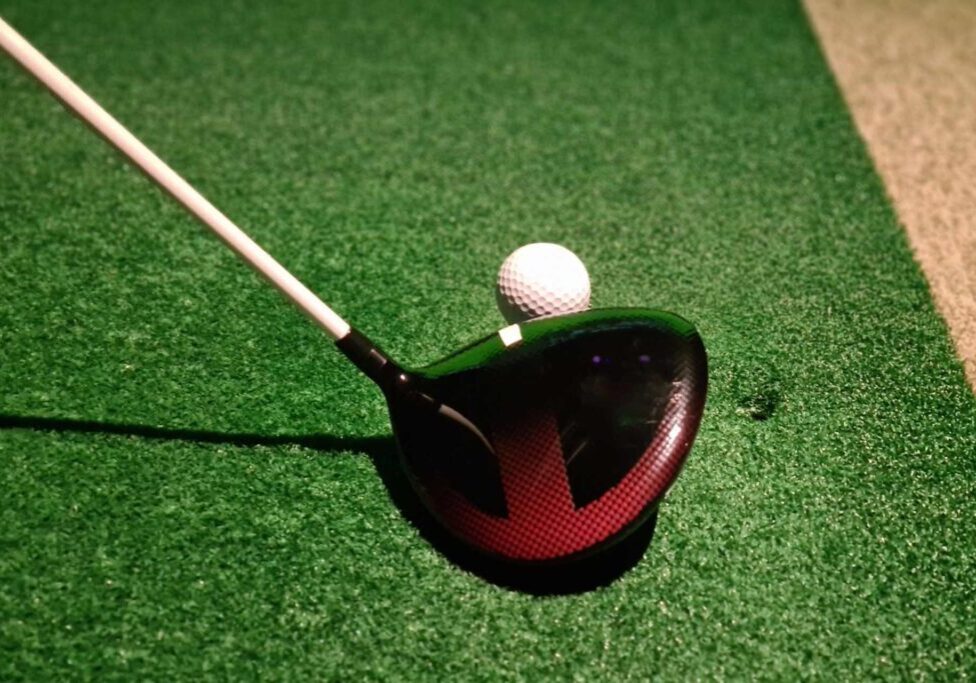
Understanding the characteristics of your ball flight can help you diagnose issues in your swing mechanics or equipment. It empowers you to intentionally shape your shots when needed. Knowing how to manipulate your ball flight allows you to execute a wider variety of shots and adapt to different situations on the course.
An indoor golf simulator like the TrackMan Simulator can provide comprehensive data and feedback crucial for improving your golf performance. By providing precise measurements of key shot parameters, the simulator enables golfers to refine their swing mechanics, optimize club selection, and develop strategic decision-making skills. This detailed insight can allow you to identify your strengths, weaknesses, and areas for improvement.
Here are the metrics the TrackMan Simulator can track:
1. Ball Speed
Ball speed is one of the primary determinants of how far the ball will travel. The distance off the tee and with approach shots significantly impacts a player’s ability to reach greens in regulation and set up scoring opportunities. The TrackMan Simulator measures the initial velocity of the ball at impact. By measuring ball speed, you can evaluate the effectiveness of your swing and the quality of contact with the ball. Consistently high ball speeds can indicate efficient energy transfer and solid contact while lower ball speeds may suggest areas for improvement in swing mechanics or equipment. Knowing the initial velocity of the ball at impact helps golfers and club fitters select the most suitable equipment to optimize performance. Matching equipment to your swing characteristics can lead to improved distance, accuracy, and overall consistency. Measuring the initial velocity of the ball at impact provides valuable insights for evaluating performance, optimizing equipment, and guiding training efforts to improve as a golfer.
2. Launch Angle
The TrackMan Simulator tracks the launch angle, which is the initial angle at which the ball leaves the clubface. Achieving the optimal launch angle for each shot is essential for maximizing distance and carry. A properly optimized launch angle ensures that the ball achieves the ideal combination of carry and roll for maximum overall distance. Measuring the launch angle can help you assess the quality of your all striking and the consistency of your swing mechanics. Adjusting the launch angle will allow you to optimize ball flight for specific situations, such as hitting high shots to carry hazards or low shots to control distance in windy conditions. It can also help you match the launch characteristics of clubs, including loft and lie angle, to your swing tendencies, leading to more consistent and reliable ball flight patterns.
3. Spin Rate
Spin rate dictates the amount of backspin or sidespin on the ball, which directly affects its trajectory through the air. Backspin creates lift, helping the ball stay airborne longer and achieve a higher trajectory while side spin influences the curvature of the ball’s flight path. The TrackMan Simulator can track the ball’s revolutions per minute (RPM). Measuring spin rate can allow you to assess the quality of your ball striking and the effectiveness of your shot execution. Spin rate directly affects the ball’s ability to stop or hold its position upon landing on the green. By understanding the spin rate of your shots, you can better predict how the ball will behave upon landing and adjust your strategy accordingly. Controlling spin rate can help you optimize distance, trajectory, and accuracy for each shot. By considering the expected spin and roll characteristics of your shots, you can select landing areas and target locations that offer the best chance of success, whether it’s holding the green or using slopes to funnel the ball closer to the hole.
4. Carry Distance
Golf courses often feature various hazards such as bunkers, water hazards, and rough areas that players must navigate to reach the green. The carry distance represents the distance the ball travels through the air before landing, allowing you to determine whether you can clear these hazards safely and reach the desired landing area. Carry distance directly impacts a player’s ability to position the ball effectively for scoring opportunities. Longer carry distances off the tee and on approach shots can lead to shorter putts and easier birdie attempts, ultimately contributing to lower scores and improved performance on the course. Furthermore, knowing the carry distance for each club in your bag can enable you to make informed decisions for a given shot. By accurately gauging the carry distance required to clear any intervening hazards and reach the target landing area, you can select the appropriate club and execute the shot with confidence.
5. Total Distance
Total distance represents the total distance the ball travels from the point of impact to its final resting position, including both carry and roll. It is essential for reaching greens in regulation and positioning the ball effectively on fairways. Shots that travel farther overall leave players with shorter approach shots and easier putts, increasing the likelihood of making pars or birdies and improving overall performance on the course. The TrackMan Simulator tracks the total distance the ball travels, including roll, which can allow you to assess the effectiveness of your shot executions and consistency of your ball striking. Additionally, by understanding your total distances with each club, you can better control the distance and trajectory of your shots to reach specific targets on the course. This allows you to avoid hazards, navigate challenging holes, and set up scoring opportunities more effectively.
6. Flight Time
Flight time reflects the duration the ball spends in the air from the moment of impact until it reaches its peak height and begins to descend. The TrackMan Simulator tracks the amount of the time the ball spends in the air, which can allow you to evaluate the quality of your shots and the effectiveness of your swing mechanics. Consistent flight times indicate solid contact and proper energy transfer, while variations in flight time may reveal areas for improvement or inconsistencies in the swing. Flight time is also closely related to carry distance. A longer flight time generally correlates with greater carry distance, indicating a higher launch angle and more efficient energy transfer from the clubface to the ball. Understanding flight time can help you gauge the distance your shots will travel and make informed decisions about club selection and strategy. Monitoring flight time can help you adjust your swing mechanics, club selection, and shot strategy to achieve optimal results and maximize your performance.
7. Apex Height
The TrackMan Simulator tracks the apex height, which is the highest point the ball reaches during its flight. Controlling the apex height allows golfers to shape their shots and adjust for various course conditions, such as wind direction and elevation changes. Different shot types, such as high shots to carry hazards or low shots to control distance, require precise control over apex height. Apex height also influences the carry distance of a golf shot. Shots with higher apex heights typically result in greater carry distances, as the ball spends more time in the air and descends at a steeper angle. Understanding and optimizing the apex height can help you maximize distance and reach specific targets on the course more effectively.
Understanding your ball flight is essential for improving your game, optimizing your performance, and achieving success in golf. Using a golf simulator like the TrackMan Simulator to track your ball flight metrics can provide valuable and detailed insights to allow you to diagnose swing flaws, make necessary adjustments, and strive for consistency in your game. By comprehending how your shots behave in various conditions, you can make informed decisions and continually refine your skills to reach your full potential as a golfer.
